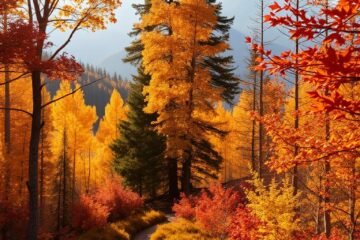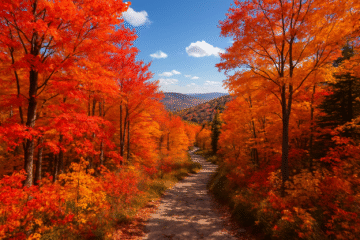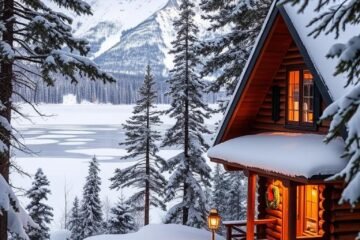Exploring the Grand Canyon is a bucket-list adventure for many. This national park spans 300 miles and features extreme temperature variations, from sub-zero to 120°F. Its unique microclimates, shaped by elevation differences, create distinct weather patterns between the South Rim, North Rim, and canyon floor.
Seasonal planning is crucial for a safe and enjoyable trip. Spring and fall offer mild temperatures, while summer brings intense heat, especially at the canyon floor. Winter hiking is possible but requires extra preparation for snow and cold conditions.
Understanding these factors ensures a memorable experience. Whether you’re a seasoned hiker or a first-time visitor, timing your visit right makes all the difference.
Table of Contents
Key Takeaways
- Grand Canyon’s microclimates vary significantly between rims and the canyon floor.
- Spring and fall are ideal for hiking due to mild weather.
- Summer temperatures can reach 120°F at the canyon floor, making hiking challenging.
- Winter hiking requires special gear for snow and cold conditions.
- Elevation impacts temperature, with a 5.5°F increase per 1,000 ft loss.
Why Timing Matters for Your Grand Canyon Hike
Timing your visit to the Grand Canyon is crucial for safety and enjoyment. The park’s unique microclimates create extreme temperature variations, with the canyon bottom often 20-30°F hotter than the rims due to temperature inversion. This phenomenon makes summer hikes at lower elevations particularly dangerous, with temperatures reaching up to 120°F.

Each season brings its own challenges. Summer heat can lead to heat stroke, while winter’s icy trails and sub-zero temperatures pose hypothermia risks. Monsoon season, from June to September, adds flash floods and lightning to the mix, making trail safety unpredictable.
Search-and-rescue teams respond to over 700 incidents annually, many caused by poor timing decisions. Proper planning reduces these risks and ensures a smoother experience. For example, spring and fall offer milder weather, but even then, sudden temperature changes can catch visitors off guard.
Wildlife activity also varies by season. Elk rutting in fall and increased snake activity in summer add another layer of consideration for hikers. Additionally, the North Rim closes from November to May, limiting access to certain trails and facilities.
Understanding these factors helps you choose the right time for your adventure. Whether you’re avoiding extreme heat, icy trails, or monsoon risks, proper timing ensures a safer and more enjoyable hike.
The Best Time of Year to Hike the Grand Canyon: Seasonal Breakdown
Seasonal changes greatly influence hiking conditions in the Grand Canyon. Each season brings unique challenges and opportunities, making it essential to plan accordingly. Below is a detailed breakdown of what to expect throughout the year.
Spring (April-June): Ideal Temperatures and Wildflowers
Spring is one of the most popular times to visit. Mild weather with low rainfall and cooler temperatures makes hiking comfortable. Wildflowers bloom, adding vibrant colors to the trails. This season is perfect for exploring the South Rim and enjoying the park’s natural beauty.
Summer (July-August): Extreme Heat and Monsoon Risks
Summer brings intense heat, with temperatures often exceeding 100°F at the canyon floor. Monsoon season adds brief but intense thunderstorms, increasing the risk of flash floods. Hikers should carry extra water and avoid midday excursions to stay safe.
Fall (September-November): Crowd-Free and Mild Weather
Fall offers pleasant weather with fewer visitors, making it an ideal time for hiking. Temperatures are mild, avoiding the summer heat and winter cold. This season is perfect for those seeking solitude and stunning autumn views.
Winter (December-March): Snowy Trails and Solitude
Winter transforms the Grand Canyon into a snowy wonderland. The South Rim averages 50-100 inches of snow annually, creating picturesque landscapes. Bright Angel Trail often requires microspikes due to icy conditions. While the North Rim roads are closed, the South Rim remains accessible with proper preparation.

| Location | Winter Temperatures |
|---|---|
| South Rim | 40°F |
| Phantom Ranch | 60°F |
Winter-specific hazards include black ice on switchbacks and snow-covered trails. However, the season offers unique photography opportunities, such as snow-dusted buttes. For a memorable experience, consider the Grand Canyon Railway Polar Express packages.
South Rim vs. North Rim: Key Differences by Season
Understanding the differences between the South Rim and North Rim is essential for planning your Grand Canyon adventure. Each area offers unique experiences, but accessibility and conditions vary significantly by season.
The North Rim is only open from mid-May through mid-October, receiving just 10% of total park visitors. In contrast, the South Rim remains accessible year-round, making it a more popular choice for travelers.

Temperature differences are notable. The North Rim is 10-15°F cooler than the South Rim, with daytime highs in the 70s-80s and nighttime lows dipping into the 20s-30s. This makes it a better option during summer months.
Elevation also plays a role. The North Rim sits 1,000 feet higher than the South Rim, starting at 8,000 feet above sea level. This contributes to its cooler climate and more challenging trails.
Shuttle services differ as well. The South Rim offers free shuttle buses within the park, while the North Rim requires advance reservations for shuttles.
Unique features set each rim apart. The South Rim boasts iconic viewpoints like Mather Point, while the North Rim offers stunning spots like Cape Royal and Angel’s Window.
| Feature | South Rim | North Rim |
|---|---|---|
| Accessibility | Year-round | Mid-May to mid-October |
| Temperature | Warmer | 10-15°F cooler |
| Elevation | 7,000 feet | 8,000 feet |
| Shuttle Service | Free | Reservation required |
Lodging options also vary. The South Rim has multiple in-park hotels, while the North Rim offers limited lodging at the Grand Canyon Lodge. Plan ahead to secure accommodations.
For those considering Rim-to-Rim hikes, the window of opportunity is narrow. The North Rim road closure limits access from late October to mid-May. Timing is critical for this challenging trek.
Hiking the Grand Canyon’s Inner Corridor
Venturing into the inner corridor of this iconic destination offers a unique blend of challenges and rewards. From rugged trails to stunning river views, this area is a haven for adventurers seeking unforgettable experiences.

Phantom Ranch and Bright Angel Trail Conditions
Phantom Ranch, nestled at the canyon’s bottom, is a popular stop for hikers. Bright Angel Trail, one of the most well-maintained routes, provides access to this oasis. Water is available at specific points along the trail, but hikers must treat water from the Colorado River.
During colder months, trails like Bright Angel may require microspikes due to icy conditions. Always check water status at the Visitor Center or Backcountry Information Center before starting your hike.
Colorado River Rafting Synergies
Rafting on the Colorado River is a thrilling way to explore the canyon. The river’s water temperature remains at 52°F year-round, making it ideal for rafting. Prime rafting season runs from April to October, offering calm waters and stunning scenery.
For those combining hiking and rafting, Tuckup Canyon offers a 70-mile network of trails and river access. Essential gear includes heavy-duty water filters, dry bags, and quick-dry clothing.
Permits are required for both commercial and private trips. Put-in points like Lee’s Ferry and take-out spots such as Diamond Creek are common for rafting itineraries. Whether you choose motorized or oar rafting, each experience offers a unique perspective of the canyon.
For more details on planning your adventure, check out our guide to Colorado River rafting.
Weather and Temperature Extremes to Prepare For
Navigating the Grand Canyon’s weather extremes is key to a safe and enjoyable hike. The park’s desert climate creates drastic temperature shifts, with a 5.5°F increase per 1,000 feet elevation loss. At the canyon floor, temperatures can soar to a record 120°F, making hydration and sun protection essential.

Hyperthermia is a major risk during summer months. Shade temperatures at Phantom Ranch average 80-90°F, but full sun can feel 20-30°F hotter. To manage heat, stay soaking wet and wear water-holding clothing. In contrast, winter brings hypothermia risks, especially at higher elevations where snowfall is common.
Monsoon season, from mid-July to early September, adds another layer of complexity. Afternoon thunderstorms build quickly, bringing lightning and flash floods. Always check real-time weather alerts from NOAA before heading out.
UV index variations by elevation also demand attention. Higher elevations expose hikers to stronger UV rays, increasing the risk of sunburn. Layering systems are crucial for managing temperature swings. Start with moisture-wicking base layers, add insulating mid-layers, and finish with a weatherproof outer shell.
Understanding these weather patterns ensures a safer experience. Whether you’re braving summer heat or winter snow, proper preparation is your best defense against the elements.
Crowds and Visitor Trends: When to Go for Peace
Understanding visitor trends helps you plan a more peaceful trip. The South Rim attracts 90% of the park’s visitors, making it the busiest area. December sees 60% fewer visitors compared to June, offering a quieter experience.
Monthly visitation statistics show a clear pattern. January and February are the least crowded, with around 200,000 visitors each. Numbers peak in July, reaching over 660,000. October is ideal for avoiding crowds, with pleasant weather and fewer visitors.
Parking and shuttle wait times vary by season. During peak months, lots fill by mid-morning, and shuttle lines can exceed 30 minutes. Shoulder seasons like April and October offer shorter waits and easier access.
Trail choices also impact your experience. Hermit Trail is less crowded than Bright Angel, offering solitude and stunning views. For photography, golden hours at sunrise and sunset provide softer light and fewer crowds.
Secret overlooks like Shoshone Point and Roosevelt Point are hidden gems. These spots are rarely crowded, offering breathtaking views without the hustle.
| Month | Visitors |
|---|---|
| January | 206,859 |
| February | 208,102 |
| March | 416,210 |
| April | 492,872 |
| May | 559,245 |
| June | 591,516 |
| July | 663,788 |
| August | 594,167 |
| September | 508,392 |
| October | 495,021 |
| November | 356,668 |
| December | 311,816 |
By planning your trip around these trends, you can enjoy a more serene and memorable experience. Whether you seek solitude or stunning views, timing your visit right makes all the difference.
Essential Gear for Each Season
Packing the right gear is essential for a successful Grand Canyon adventure. Each season demands specific equipment to handle the park’s extreme conditions. Whether you’re braving icy trails or scorching heat, having the right tools ensures safety and comfort.
Winter: Microspikes and Layered Clothing
Winter hikes require specialized gear to handle snow and icy trails. Microspikes are a must for traction on slippery surfaces, especially on popular routes like Bright Angel Trail. Layered clothing is equally important, starting with thermal tops and insulated jackets to retain body heat.
Accessories like a warm beanie and gloves protect against frostbite during sub-zero temperatures. Waterproof shoes with good traction are essential for navigating icy conditions safely. Always check trail conditions before heading out to ensure you’re adequately prepared.
Summer: Hydration Packs and Sun Protection
Summer hikes in the desert heat demand careful planning. A minimum 3-liter hydration pack is crucial to stay hydrated throughout the day. Collapsible water bottles provide extra capacity for longer treks.
Sun protection is equally vital. Wide-brimmed hats and UPF 50+ clothing shield against harmful UV rays. Lightweight, breathable fabrics help regulate body temperatures in the scorching heat. Electrolyte replacement through salty snacks prevents dehydration during strenuous hikes.
Cooling gear like evaporative towels and portable misters offer relief from the intense sun. Always carry a water filter for natural sources, especially during muddy conditions. Proper preparation ensures a safe and enjoyable summer hike.
Safety Tips for Year-Round Hiking
Staying safe while exploring this iconic destination requires careful preparation and awareness. The NPS “Hike Smart” principles are a great starting point. Research your trail, check the weather, and stay hydrated to avoid common pitfalls.
Emergency communication devices like PLBs or satellite messengers are essential. Cell reception is limited, and these tools can save lives in critical situations. Always inform someone of your plans before heading out.
Wildlife encounters are part of the experience. Maintain a safe distance from elk, condors, and snakes, especially during warmer months. Use insect repellent to avoid bites and stay alert on the trail.
Mandatory safety gear varies by season. In winter, microspikes and layered clothing are crucial for icy conditions. Summer demands hydration packs and sun protection to combat extreme temperatures.
Be aware of “red flag” weather signs. Thunderstorms, flash floods, and extreme heat can pose serious risks. Always check weather updates and avoid hiking during dangerous conditions.
Training regimens are vital for handling elevation changes. Build endurance and strength to tackle steep terrain safely. Remember, 80% of rescues involve inadequate water, so plan your time wisely and turn around by 1 PM at the latest.
Planning Your Trip: Permits, Lodging, and Logistics
Planning a trip to this iconic destination requires attention to permits, lodging, and logistics. Whether you’re visiting for a day or a week, proper preparation ensures a smooth and enjoyable experience.
Securing permits is a critical first step. Phantom Ranch, a popular lodging option, requires reservations through a lottery system 15 months in advance. Backcountry permits are available four months ahead, with applications submitted via fax, mail, or in person. Fees include a $10 non-refundable application fee and $12 per person per night below the rim.
Lodging options vary widely. El Tovar offers historic charm, while Yavapai Lodge provides modern amenities. For a unique experience, consider Roam America Horseshoe Bend or Backland Luxury Camping, both offering glamping options with stunning views.
Transportation choices include shuttles and private vehicles. The park’s free shuttle system is convenient, but private vehicles offer flexibility for exploring nearby areas. Gateway towns like Tusayan and Flagstaff provide additional amenities, including dining and lodging.
Sample itineraries can help structure your trip. For a one-day visit, focus on the South Rim’s iconic viewpoints. A three-day itinerary might include hiking Bright Angel Trail and exploring Phantom Ranch. Five-day trips allow for deeper exploration, including rafting on the Colorado River.
| Lodging Option | Features |
|---|---|
| El Tovar | Historic charm, fine dining |
| Yavapai Lodge | Modern amenities, family-friendly |
| Roam America Horseshoe Bend | Glamping, scenic views |
| Backland Luxury Camping | Chef-prepared meals, private patios |
For those planning to visit Havasupai Falls, a valid passport is required for permit applications. This ensures compliance with tribal regulations and smooth entry into the area.
By addressing permits, lodging, and logistics early, you can focus on enjoying your visit to this breathtaking destination. Proper planning ensures a memorable and stress-free adventure.
Conclusion
Choosing the right season to visit this iconic destination ensures a memorable experience. Spring and fall are favored by 78% of visitors for their mild weather and optimal hiking conditions. These periods offer moderate temperatures and fewer crowds, making them ideal for exploring the park’s trails.
Winter provides unique opportunities for solitude and photography, with snow-dusted landscapes creating stunning views. However, it requires proper gear and preparation for icy trails and cold conditions. Summer, while popular, brings extreme heat and higher visitor numbers, especially in the inner canyon.
For those seeking a quieter adventure, the North Rim offers a less crowded experience during its open season. Always check NPS webcams and alerts for real-time updates on weather and trail conditions. Whether you prefer vibrant spring blooms or winter’s serene beauty, planning ahead ensures a safe and enjoyable trip.



0 Comments